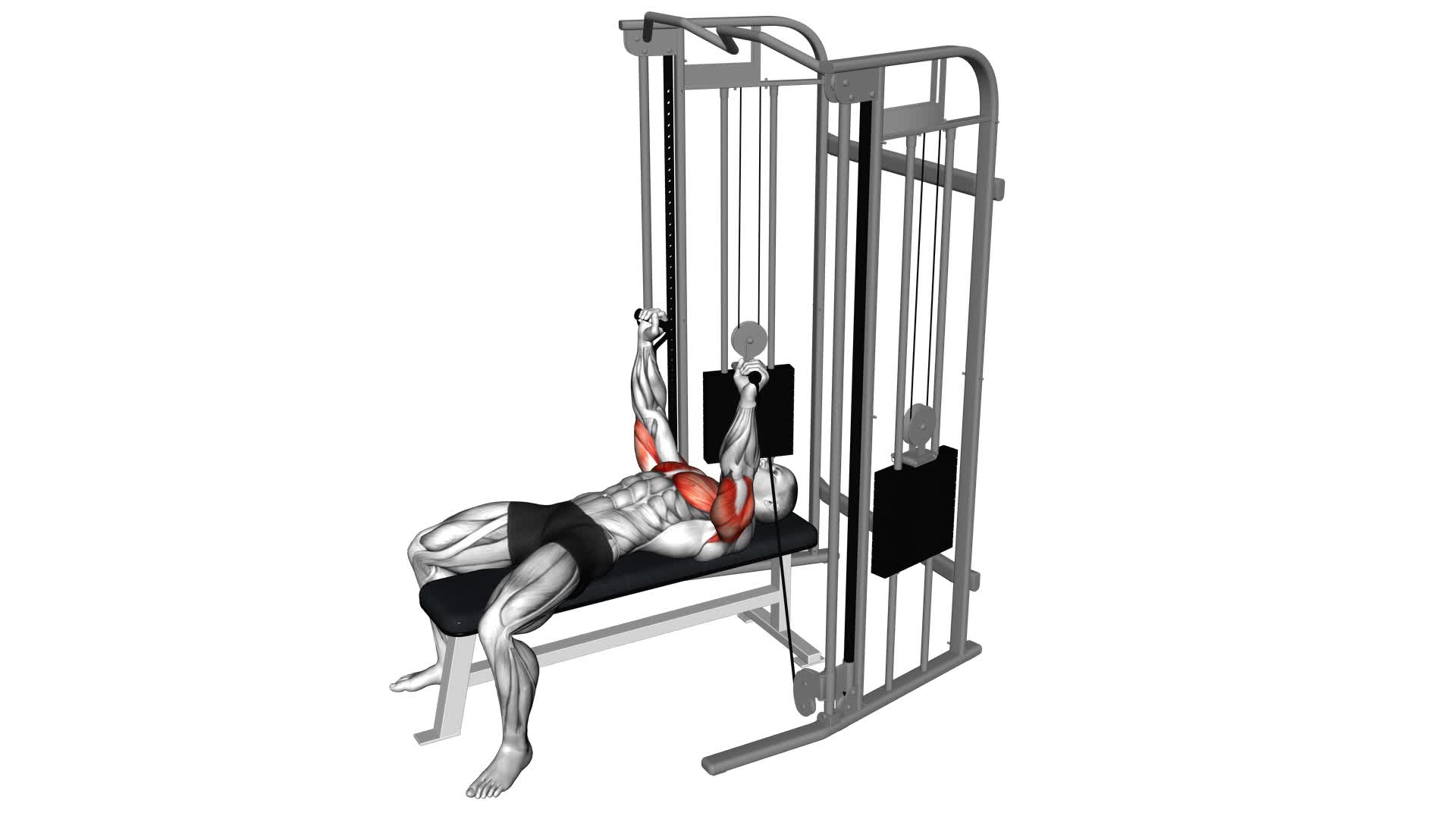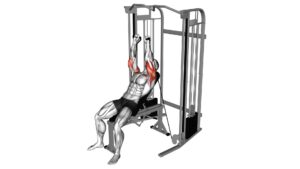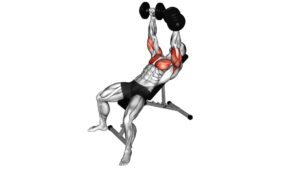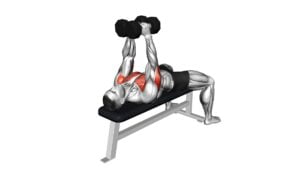Cable Bench Press – Video Exercise Guide & Tips

Are you looking to level up your strength training routine? Look no further than the cable bench press! This dynamic exercise targets multiple muscle groups, helping you build lean muscle and increase upper body strength.
Watch This Exercise Video
In this article, we'll guide you through proper form and technique, offer variations and modifications, and provide tips for maximizing your results.
Plus, we've included a sample cable bench press workout routine to get you started on your fitness journey.
Let's get those gains!
Key Takeaways
- Cable bench press provides constant tension throughout the movement, promoting muscle growth.
- It offers versatility with adjustable pulleys to target different muscle groups from various angles.
- Cable bench press is suitable for individuals with shoulder issues or limited mobility due to the greater range of motion.
- Proper form and technique are important to prevent injury and effectively work chest muscles.
Benefits of Cable Bench Press
Discover the numerous benefits you can experience by incorporating cable bench press into your workout routine. The cable bench press offers several advantages that can enhance your strength training and overall fitness.
One of the key benefits is the constant tension provided by the cables throughout the movement. Unlike traditional barbell bench presses, where tension is reduced at the top of the movement, the cables keep the muscles engaged from start to finish. This consistent tension helps to increase muscle activation and promote muscle growth.
Another advantage of the cable bench press is its versatility. The adjustable pulleys allow you to target different muscle groups by changing the angle and position of the cables. This flexibility enables you to work your chest, shoulders, and triceps from various angles, providing a more well-rounded workout.
Furthermore, the cable bench press is a great option for individuals with shoulder issues or limited mobility. The cables allow for a greater range of motion, reducing strain on the shoulders and allowing you to perform the exercise with proper form and technique.
Incorporating cable bench press into your routine can lead to improved muscle strength, increased muscle size, and enhanced overall fitness.
Now, let's delve into the importance of proper form and technique to maximize the benefits of this exercise.
Proper Form and Technique
To maximize the benefits of the cable bench press, ensure proper form and technique. Proper form is essential to prevent injury and target the right muscles effectively. One common mistake is arching your back excessively. This puts unnecessary strain on your lower back and reduces the effectiveness of the exercise. Keep your back flat against the bench throughout the movement.
Another mistake is flaring your elbows out to the sides. This places excessive stress on your shoulders and increases the risk of injury. Instead, keep your elbows tucked in at a 45-degree angle to your body.
Safety precautions are also important when performing the cable bench press. Make sure the weight is appropriate for your strength level. Start with a lighter weight and gradually increase as you become more comfortable and confident. Always warm up before starting your workout to prepare your muscles and joints for the exercise.
Lastly, listen to your body and stop immediately if you experience any sharp pain or discomfort. By maintaining proper form and taking necessary safety precautions, you can perform the cable bench press effectively and safely.
Muscle Groups Targeted
When performing the cable bench press, you engage several key muscle groups.
This exercise primarily targets your chest muscles, including the pectoralis major and pectoralis minor.
Additionally, it also activates your triceps, anterior deltoids, and serratus anterior muscles.
Key Muscle Groups
To effectively target and engage multiple muscle groups, incorporate the cable bench press into your workout routine.
The cable bench press primarily targets the chest muscles, specifically the pectoralis major and minor. These muscles are responsible for the horizontal adduction of the shoulder, which is the movement of bringing your arms together in front of your body.
Additionally, the cable bench press also engages the triceps brachii, which are the muscles located on the back of your upper arm. These muscles are responsible for extending the elbow joint.
Targeted Muscle Activation
The cable bench press targets and activates multiple muscle groups, including the chest muscles and triceps brachii, for a comprehensive upper body workout.
To optimize muscle activation during the cable bench press, it's important to employ effective muscle engagement strategies. One technique is to focus on maintaining proper form throughout the exercise. This includes keeping your back flat against the bench, engaging your core muscles, and ensuring that your elbows are at a 90-degree angle when lowering the weights.
Additionally, using a controlled and deliberate tempo can enhance muscle activation by maximizing time under tension. By slowing down the movement and emphasizing the contraction of the targeted muscles, you can effectively engage and activate the chest muscles and triceps brachii during the cable bench press.
Variations and Modifications
Enhance your cable bench press routine with a variety of modifications to target different muscle groups and challenge your strength and stability.
Cable bench press variations can help you add variety to your workouts and prevent plateaus in your progress.
One option is the incline cable bench press, which targets your upper chest and shoulders more than the traditional flat bench press. To perform this variation, adjust the bench to a 45-degree angle and use the cable machine instead of dumbbells or a barbell.
Another modification is the decline cable bench press, which primarily works your lower chest muscles. Set the bench at a decline angle and use the cable machine for resistance.
You can also try the single-arm cable bench press to engage your core and improve stability. Instead of using both arms, grab one handle and perform the bench press motion. This variation challenges your balance and coordination.
Remember to adjust the weight according to your strength level and always maintain proper form to avoid injury.
Incorporating these cable bench press modifications into your routine will help you target different muscle groups and keep your workouts challenging and effective.
Tips for Maximizing Results
To maximize your results, consistently incorporate these tips into your cable bench press routine.
First and foremost, ensure that you're using the right equipment for your cable bench press. You'll need a cable machine with a bench and a set of cables with handles. Make sure that the cables are properly adjusted to the appropriate height for your exercise.
One of the most common mistakes people make when performing the cable bench press is using too much weight. It's important to start with a weight that allows you to maintain proper form and technique. Gradually increase the weight as you become stronger and more comfortable with the exercise.
Another mistake to avoid is using momentum to lift the weight. Remember to keep the movement slow and controlled, focusing on contracting your chest muscles throughout the exercise. This will ensure that you're targeting the right muscles and maximizing your results.
Additionally, it's crucial to maintain proper form during the cable bench press. Keep your back flat against the bench, your feet planted firmly on the ground, and your elbows at a 90-degree angle. This will help to prevent injury and ensure that you're effectively working your chest muscles.
Sample Cable Bench Press Workout Routine
Now that you have a good understanding of the cable bench press exercise, it's time to focus on creating a sample workout routine.
This routine will help you optimize your cable position and achieve the best results. Additionally, we'll provide recommendations for the ideal rep range to maximize your strength and muscle gains.
Let's get started!
Optimal Cable Position
Place the cable at a height that allows you to comfortably perform the cable bench press exercise. To find the optimal cable position, follow these steps:
- Set the cable at chest level: Adjust the cable machine so that the handles are at the same height as your chest. This ensures that you can maintain proper form and execute the exercise effectively.
- Position the cable in line with your body: Make sure the cable is aligned with your chest and shoulders. This ensures that the resistance is evenly distributed and targets the intended muscles.
- Maintain a slight angle: Angle the cables slightly downward towards your body. This helps engage your chest muscles and prevents unnecessary strain on your shoulders.
Rep Range Recommendations?
For optimal results with the cable bench press, it's important to consider the recommended rep range for your workout routine. The ideal rep range for this exercise is typically between 8 and 12 repetitions per set. This range allows you to work on both strength and muscle endurance.
It's recommended to start with a weight that challenges you but still allows you to maintain proper form throughout the set. As you progress, you can gradually increase the weight to continue challenging your muscles.
Remember to use proper breathing technique during the cable bench press. Inhale as you lower the weight and exhale as you push it away from your body. This helps maintain stability and control during the exercise.
Frequently Asked Questions
How Much Weight Should I Use for Cable Bench Press?
To determine the correct weight for cable bench press, you need to consider your fitness level and goals. Start with a weight that challenges you but allows you to maintain proper form.
Gradually increase the weight as you get stronger. Remember, using too heavy of a weight can compromise your form and increase the risk of injury.
Also, try different variations of the exercise to target different muscle groups and keep your workouts interesting.
Can Cable Bench Press Help Improve My Posture?
Cable bench press is an effective exercise that can help improve your posture. By targeting the muscles in your chest, shoulders, and upper back, it strengthens and stabilizes your upper body, which can contribute to better posture.
Unlike traditional bench press, cable bench press allows for a wider range of motion and provides constant tension throughout the movement. This can lead to increased muscle activation and ultimately, better posture.
Is Cable Bench Press Suitable for Beginners?
Yes, cable bench press is suitable for beginners. It's a great exercise to start with because it allows you to control the resistance and focus on proper form.
Cable bench press variations can help you build strength and muscle in your chest, shoulders, and triceps. The cables provide constant tension throughout the movement, which can lead to better muscle activation.
Should I Use a Wide or Narrow Grip for Cable Bench Press?
When doing the cable bench press, you might wonder whether to use a wide or narrow grip. The grip you choose depends on your goals. A wide grip targets the outer chest muscles, while a narrow grip focuses more on the inner chest.
Both grips have benefits for chest development. Experiment with both to see which feels most effective for you. Remember to maintain proper form and engage your chest muscles throughout the movement.
Can Cable Bench Press Help With Shoulder Stability?
Cable bench press is a great exercise for improving shoulder stability. By incorporating this exercise into your routine, you can strengthen the muscles surrounding your shoulders and enhance their stability.
It's also beneficial for shoulder mobility, as it requires a controlled range of motion. Cable exercises, in general, have been known to provide numerous benefits for the shoulders.
Conclusion
In conclusion, the cable bench press is a highly effective exercise for targeting multiple muscle groups in the upper body. By using proper form and technique, you can maximize results and prevent injury.
Adding variations and modifications to your workout routine can keep it challenging and prevent plateaus. Remember to consult with a fitness professional before attempting any new exercises to ensure safety and proper form.
Incorporate the cable bench press into your routine for improved strength and muscle development.

Author
Years ago, the spark of my life’s passion ignited in my mind the moment I stepped into the local gym for the first time. The inaugural bead of perspiration, the initial endeavor, the very first surge of endorphins, and a sense of pride that washed over me post-workout marked the beginning of my deep-seated interest in strength sports, fitness, and sports nutrition. This very curiosity blossomed rapidly into a profound fascination, propelling me to earn a Master’s degree in Physical Education from the Academy of Physical Education in Krakow, followed by a Sports Manager diploma from the Jagiellonian University. My journey of growth led me to gain more specialized qualifications, such as being a certified personal trainer with a focus on sports dietetics, a lifeguard, and an instructor for wellness and corrective gymnastics. Theoretical knowledge paired seamlessly with practical experience, reinforcing my belief that the transformation of individuals under my guidance was also a reflection of my personal growth. This belief holds true even today. Each day, I strive to push the boundaries and explore new realms. These realms gently elevate me to greater heights. The unique combination of passion for my field and the continuous quest for growth fuels my drive to break new ground.







